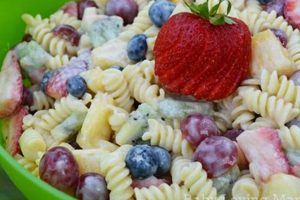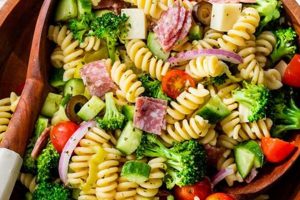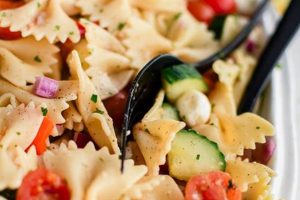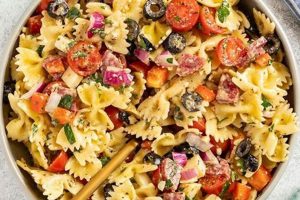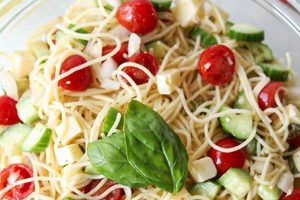This dish combines the classic flavors of deviled eggs with the versatility of pasta salad. Typically, it involves cooked pasta tossed with a creamy dressing made from mayonnaise, mustard, vinegar, and seasonings. Hard-boiled eggs, chopped and mashed, are incorporated into the dressing, creating a rich, tangy base. Variations may include additions such as celery, onion, relish, paprika, and other spices. The dish is served chilled, making it a popular choice for picnics, potlucks, and summer gatherings.
The appeal lies in its familiar comfort food profile, combining well-loved elements into a refreshing and satisfying dish. Its adaptability makes it suitable for a variety of occasions, from casual weeknight meals to more festive gatherings. The creamy texture and savory flavors are generally appealing to a broad range of palates, while the inclusion of eggs provides a good source of protein. Historically, egg salad and pasta salads have been separate culinary traditions, converging in more recent times to create this combined dish, capitalizing on the convenience and enjoyment of both.
The following sections will delve into specific recipe variations, covering ingredient selection, preparation techniques, and presentation suggestions for creating a perfect version of this crowd-pleasing dish.
Tips for Crafting the Perfect Deviled Egg Pasta Salad
Elevating this classic dish requires attention to detail and a few key techniques. The following tips offer guidance for achieving optimal flavor and texture.
Tip 1: Perfectly Cooked Pasta: Pasta should be cooked al dente for ideal texture within the salad. Overcooked pasta becomes mushy and absorbs too much dressing.
Tip 2: Egg Quality Matters: Fresh, high-quality eggs yield the best flavor and texture. Ensure eggs are cooked thoroughly and cooled completely before incorporating them into the dressing.
Tip 3: Balancing Tang and Creaminess: The dressing’s balance of tanginess from vinegar or mustard and creaminess from mayonnaise is crucial. Adjust these elements to achieve the desired flavor profile.
Tip 4: Enhancing Flavor with Seasonings: Paprika, celery seed, onion powder, and fresh herbs can elevate the complexity of the dish. Experimentation is encouraged to find preferred flavor combinations.
Tip 5: The Importance of Chilling: Chilling allows the flavors to meld and the salad to achieve optimal serving temperature. Refrigerate for at least one hour before serving.
Tip 6: Texture Variation through Add-ins: Consider incorporating chopped celery, red onion, bell peppers, or relish for added texture and flavor complexity.
Tip 7: Presentation Considerations: Garnish the salad with fresh herbs, a sprinkle of paprika, or reserved chopped egg for an appealing presentation.
By following these tips, one can create a deviled egg pasta salad that balances flavor, texture, and visual appeal, guaranteeing a satisfying culinary experience.
The following section provides concluding remarks and further inspiration for variations and pairings.
1. Classic Creamy Dressing
Classic creamy dressing forms the foundational element of deviled egg pasta salad. This dressing emulates the filling found in traditional deviled eggs, providing the characteristic tangy, rich flavor profile that defines the dish. Its composition typically involves mayonnaise, mustard, vinegar, and seasonings, creating a cohesive binder for the pasta and other ingredients. The dressing’s quality directly impacts the overall success of the pasta salad; an improperly balanced dressing can result in a bland or overly acidic final product. For instance, using excessive mayonnaise can create a heavy, cloying texture, while insufficient vinegar can diminish the necessary tang. Furthermore, the choice of mustardyellow, Dijon, or stone-groundintroduces subtle flavor nuances that further shape the character of the dish.
The creamy dressing serves several crucial functions beyond flavor. It acts as a binding agent, coating the pasta and ensuring even distribution of ingredients. This coating also helps prevent the pasta from drying out, maintaining a desirable texture, particularly after chilling. The emulsification of the mayonnaise with the other ingredients creates a smooth, palatable consistency that complements the textural elements provided by the pasta and any added vegetables. A well-executed dressing contributes significantly to the overall enjoyment of the dish, transforming simple ingredients into a cohesive and flavorful salad.
Understanding the importance of the classic creamy dressing within deviled egg pasta salad allows for informed recipe adaptation and flavor customization. Awareness of the interplay between mayonnaise, mustard, and vinegar enables adjustments tailored to individual preferences. One might opt for a lighter dressing with reduced mayonnaise and increased vinegar for a brighter, more acidic profile. Alternatively, incorporating Dijon mustard introduces a sharper tang compared to traditional yellow mustard. Mastery of the dressing allows for both classic renditions and innovative variations, ensuring a satisfying culinary experience.
2. Perfectly Cooked Pasta
Pasta, the foundational ingredient, plays a pivotal role in a successful deviled egg pasta salad. The pasta’s texture significantly influences the overall enjoyment of the dish. Achieving perfectly cooked pasta is crucial for balancing the creamy dressing and other components. Overcooked or undercooked pasta can detract from the intended experience, affecting both flavor absorption and textural harmony.
- Al Dente Consistency
The ideal texture for pasta in this salad is al dente, meaning “to the tooth” in Italian. This signifies a firm yet tender bite, offering a pleasant resistance without being overly chewy or mushy. Al dente pasta holds its shape well within the salad and absorbs the dressing without becoming soggy. Overcooked pasta, conversely, tends to clump together and disintegrate, resulting in a less appealing texture and potentially overwhelming the dressing.
- Pasta Shape Selection
While various pasta shapes can be used, certain shapes enhance the dish’s overall composition. Small, tubular shapes like ditalini, elbow macaroni, or rotini work well, offering ample surface area for the dressing to adhere. Their compact size also facilitates even distribution throughout the salad. Larger shapes, such as fusilli or farfalle, can also be employed, providing a visually appealing contrast but may require adjustments to the dressing consistency to ensure adequate coating.
- Cooking Process Precision
Precise cooking according to package directions ensures optimal results. Salting the boiling water generously seasons the pasta from within. The cooking time should be monitored carefully to prevent overcooking. Tasting the pasta during cooking is crucial for determining doneness and achieving the desired al dente consistency. Immediately draining the cooked pasta prevents further cooking and helps maintain the desired texture.
- Cooling and Incorporation
Rinsing the cooked pasta with cold water stops the cooking process and removes excess starch, preventing sticking and ensuring a clean flavor profile. Allowing the pasta to cool completely before incorporating it into the salad is essential. Introducing warm pasta to the dressing can cause the dressing to thin and separate, impacting the overall texture and flavor absorption.
The interplay between perfectly cooked pasta and the other components of deviled egg pasta salad is critical for achieving a harmonious balance of flavors and textures. Al dente pasta provides a pleasant textural counterpoint to the creamy dressing, while the chosen shape affects both visual appeal and dressing adherence. Precise cooking and cooling techniques ensure that the pasta integrates seamlessly with the other elements, contributing to a satisfying and enjoyable culinary experience.
3. Fresh, High-Quality Eggs
Egg quality significantly impacts the flavor, texture, and overall success of deviled egg pasta salad. Fresh, high-quality eggs contribute a rich, clean taste and desirable texture to both the yolk mixture and the white garnish, while less fresh eggs can impart off-flavors and unpleasant textures that detract from the final dish. Selecting and handling eggs properly is paramount for achieving optimal results.
- Flavor Enhancement
Fresh eggs possess a delicate, subtly sweet flavor that enhances the overall taste profile of the salad. Their yolks contribute richness and depth, complementing the creamy dressing and other ingredients. Older eggs, conversely, may develop sulfurous off-flavors that negatively impact the final dish. Flavor is paramount in this dish; the egg’s inherent taste plays a crucial role in the balance of flavors.
- Textural Integrity
Fresh egg yolks create a smooth, creamy consistency in the dressing, binding the ingredients together effectively. Fresh egg whites, when used as a garnish, offer a firm, pleasant texture. Older eggs may exhibit a watery consistency in both yolks and whites, resulting in a less appealing texture in the final salad. This textural integrity is key to a pleasant eating experience.
- Visual Appeal
Visually, fresh eggs offer vibrant, appealing yolk colors, enhancing the salad’s presentation. The whites of fresh eggs hold their shape well when chopped, contributing to an aesthetically pleasing final product. Dull yolks and watery whites from older eggs can detract from the dish’s visual appeal. Presentation matters, and fresh eggs contribute to a visually appealing salad.
- Food Safety Considerations
Using fresh, properly handled eggs minimizes food safety risks. Thorough cooking and prompt refrigeration of the finished salad are crucial. Storing eggs correctly before use also contributes to food safety. While freshness primarily impacts flavor and texture, its indirect influence on food safety should not be overlooked.
The importance of fresh, high-quality eggs in deviled egg pasta salad extends beyond mere ingredient selection. Their contribution to flavor, texture, visual appeal, and even food safety makes them a cornerstone of the dish. Understanding the nuances of egg quality allows for informed choices, elevating the final product from satisfactory to exceptional.
4. Balanced Seasonings
Balanced seasonings are essential for a flavorful deviled egg pasta salad. The interplay of spices and herbs elevates the dish beyond simple ingredients, creating depth and complexity. The inherent richness of the egg yolks and mayonnaise necessitates a careful balance of seasonings to prevent blandness and enhance the other flavors present. Seasoning choices significantly influence the final taste profile, offering opportunities for customization and creative variations.
Consider the foundational seasonings: salt and pepper. Salt enhances the inherent flavors of the other ingredients, while pepper adds a subtle heat and complexity. However, excessive salt can overpower the dish, and too much pepper can create an unpleasant bitterness. The balance between these two fundamental seasonings is crucial. Beyond salt and pepper, paprika contributes a smoky sweetness and vibrant color, often used as a garnish. Dry mustard powder adds a pungent depth, complementing the tanginess of the vinegar or mustard in the dressing. Fresh herbs, such as dill or chives, introduce a bright, herbaceous element, contrasting with the richness of the eggs and mayonnaise. For example, a salad featuring dill may evoke a lighter, summery flavor profile, while chives might contribute a more savory, oniony nuance.
Achieving balanced seasoning involves careful consideration of the overall flavor profile desired. A harmonious blend of spices and herbs complements the creamy dressing and other ingredients without overwhelming the palate. The goal is to enhance, not mask, the inherent flavors of the dish. Experimentation and tasting throughout the preparation process are essential for achieving the optimal balance, as individual preferences and ingredient variations may necessitate adjustments. Ultimately, balanced seasonings transform deviled egg pasta salad from a simple combination of ingredients into a flavorful, nuanced culinary creation.
5. Complementary Add-ins
Complementary add-ins elevate deviled egg pasta salad from a simple dish to a complex and texturally satisfying experience. These additions introduce contrasting flavors, textures, and colors, enhancing the inherent richness of the egg and mayonnaise base. Careful selection of add-ins ensures a balanced and harmonious final product, offering a broader appeal and preventing the salad from becoming monotonous. The interplay between add-ins and the core ingredients is crucial for a well-rounded and enjoyable dish.
Several categories of add-ins contribute distinct characteristics. Textural elements, such as chopped celery, red onion, or bell peppers, offer a crisp counterpoint to the creamy dressing and pasta. These additions provide a refreshing crunch, preventing the salad from becoming overly rich. Flavorful add-ins, like sweet pickle relish, chopped olives, or crumbled bacon, introduce contrasting savory or tangy notes that complement the creamy base. These additions deepen the flavor profile, preventing the salad from tasting one-dimensional. Color-enhancing add-ins, such as chopped fresh herbs (parsley, chives, dill), or a sprinkle of paprika, provide visual appeal and freshness. For example, the vibrant green of parsley contrasts beautifully with the pale yellow of the egg mixture, making the salad more visually appealing. The choice of add-ins often reflects personal preferences and desired flavor profiles; a Mediterranean-inspired version might include Kalamata olives and feta cheese, while a more traditional approach might favor celery and sweet pickle relish.
The practical significance of understanding complementary add-ins lies in the ability to customize deviled egg pasta salad to suit various tastes and occasions. Consideration of texture, flavor, and color allows for a balanced and appealing final product. A thoughtful approach to add-ins ensures that the salad remains interesting and enjoyable, appealing to a wider range of palates. Furthermore, the strategic use of add-ins allows for creative variations, transforming a classic dish into a personalized culinary expression.
6. Proper Chilling
Proper chilling is crucial for deviled egg pasta salad recipes, significantly impacting food safety, flavor development, and overall textural quality. Chilling allows the flavors of the various componentspasta, dressing, and add-insto meld and harmonize, resulting in a more cohesive and balanced flavor profile. Furthermore, chilling firms the pasta, enhancing its textural appeal within the creamy dressing. From a food safety perspective, proper chilling inhibits bacterial growth, ensuring the dish remains safe for consumption.
- Food Safety
Chilling inhibits the growth of microorganisms that can cause foodborne illness. Mayonnaise-based dressings, a key component of deviled egg pasta salad, are particularly susceptible to bacterial growth at room temperature. Prompt and adequate chilling after preparation is essential to mitigate this risk. Guidelines recommend maintaining cold foods below 40F (4C) to ensure safety.
- Flavor Development
Chilling allows the flavors of the various ingredients to meld and deepen. The initially distinct tastes of the mustard, vinegar, mayonnaise, and any added spices or vegetables harmonize over time in a cool environment. This integration creates a more complex and nuanced flavor profile than immediately after mixing. A minimum chilling time of one hour is generally recommended, but longer periods, up to 24 hours, can further enhance flavor development.
- Texture Enhancement
Chilling firms the pasta, improving its texture within the salad. Warm pasta tends to absorb the dressing more readily, potentially leading to a softer, less desirable texture. Chilling helps maintain the pasta’s structural integrity, providing a pleasant contrast to the creamy dressing. This effect is particularly noticeable with smaller pasta shapes, which are commonly used in this type of salad.
- Serving Temperature
A chilled pasta salad offers a refreshing contrast to warm weather or heavier meals. The cool temperature enhances the creamy texture of the dressing and provides a more palatable experience, especially during warmer months. Serving the salad directly from the refrigerator ensures optimal temperature and food safety.
The proper chilling of deviled egg pasta salad is integral to its success as a dish. It is not merely a final step but a critical element that influences food safety, flavor development, and textural enjoyment. By adhering to recommended chilling practices, one ensures a safer, more flavorful, and texturally satisfying culinary experience.
Frequently Asked Questions
This section addresses common inquiries regarding deviled egg pasta salad preparation and variations.
Question 1: Can different types of pasta be used?
While small, tubular pasta shapes are traditional, other shapes like rotini, farfalle, or shells can be used. The chosen shape influences dressing adherence and overall presentation. Larger shapes may necessitate adjustments to the dressing consistency.
Question 2: How long can the salad be stored?
Properly stored in an airtight container in the refrigerator, the salad typically lasts for 3-5 days. Discard any salad left at room temperature for more than two hours to minimize food safety risks.
Question 3: Can this dish be made ahead of time?
Preparing the salad a day in advance allows flavors to meld. Add delicate garnishes, such as fresh herbs, immediately before serving to maintain their visual appeal and prevent wilting.
Question 4: How can the tanginess of the dressing be adjusted?
The balance of tanginess can be adjusted by altering the amount of vinegar or mustard used. Additional sweetness can be incorporated through a touch of sugar or sweet pickle relish, balancing the acidity.
Question 5: What are suitable substitutes for mayonnaise?
Plain Greek yogurt or a combination of avocado and Greek yogurt offer lower-fat alternatives to traditional mayonnaise. These substitutions may alter the final flavor and texture.
Question 6: How can one prevent the pasta salad from becoming watery?
Ensure the pasta is cooked al dente and cooled completely before combining with the dressing. Avoid overmixing, as this can break down the pasta and release excess starch, leading to a watery consistency. Additionally, ensure all add-ins are relatively dry before incorporating them into the salad.
Careful attention to these frequently asked questions ensures successful preparation and enjoyment of deviled egg pasta salad. Addressing these common concerns optimizes the flavor, texture, and food safety of the dish.
The following section provides concluding remarks and further inspiration for variations and pairings.
Deviled Egg Pasta Salad Recipes
Exploration of deviled egg pasta salad recipes reveals a dish offering versatility and satisfying flavor profiles. Careful consideration of core componentspasta texture, egg quality, dressing consistency, seasoning balance, complementary add-ins, and chilling durationsignificantly impacts the final product. From classic renditions to innovative variations, adherence to established culinary principles ensures a successful outcome. Understanding the interplay of these elements allows for informed choices regarding ingredient selection and preparation techniques.
Deviled egg pasta salad, a dish rooted in culinary tradition yet adaptable to modern interpretations, presents opportunities for creative expression within a familiar framework. Continued exploration of flavor combinations and ingredient variations promises further evolution of this classic dish, ensuring its enduring appeal across diverse palates and culinary landscapes.

